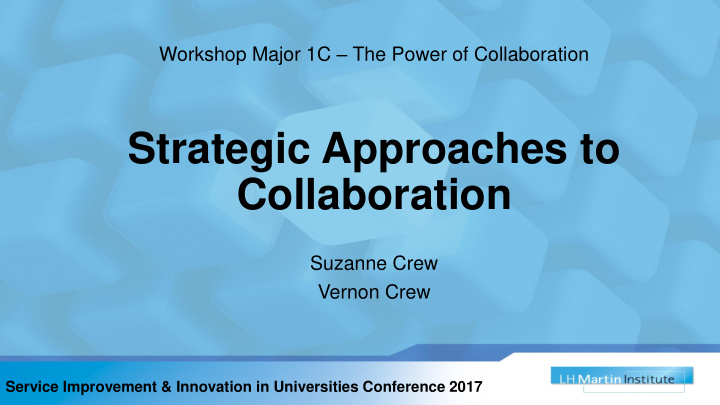



Workshop Major 1C – The Power of Collaboration Strategic Approaches to Collaboration Suzanne Crew Vernon Crew Service Improvement & Innovation in Universities Conference 2017
The strategic challenge • Universities increasingly operate in a multifaceted, networked policy and transactional environment • Leaders are confronted with problems they can’t always fix in isolation • Leaders are presented with opportunities they can’t always seize on their own
One possible answer …..... Working together and with other sectors, industries, & governments to develop collaborative arrangements that provide a win- win solution for all parties
Collaborative camps Camp 1: Transactional Camp 2: Transformational The transformational (win-win) camp: The competitive (win-lose) camp: • strategic (long-term horizon); • one-time collaboration; OR • co-creation; • short-term horizon; • propels all parties forward; • goal is to maximize own benefits. • use of unique strengths and resources; • based largely on trust; • goal is to maximize joint gains.
✔︐ Identify the driver or problem to be addressed ✔︐ Generate alternative solutions ✔︐ Select alternative solutions Checklist ✔︐ Ideate and network ✔︐ Project and change management ✔︐ Ongoing partnership management
What is your main driver for collaboration? Product Reputation Risk Markets Differentiat Profit Resources Capacity e Engagement Organisational Financial Environmental Channel Sustainability? Sustainability? Sustainability?
Which solution(s) will help you achieve your goal? SHARE EXAMPLE DRIVERS University X (lead) plus 13 international Mash-up partner universities, establish a global Mutual interest alliance for higher education and Mutual benefit collaborative research Complementary University X licences award courses to an overseas provider in different market Partnering University X and VET Provider Y share Leverage resources facilities and sub-degree curriculum with intent of attracting different markets Different markets Vertical Partnering University X, RTO Y and School Z partner to deliver Australian AQF awards and Different markets but ongoing professional development as mutual interest along TNE. supply chain University X invests in Edtech
Which solution(s) will help you achieve your goal? SHARE EXAMPLE DRIVERS Switchboard P2P – learner to learner, learner to Non-reciprocal support (Studiocity) B2B – organisation to organisation connector of multiple (OUA) partners/markets Secondary Markets University X collaborates with professional training organisation to Mutual resources provide content for short-course Different markets modules Competency Research Hubs Tech Hubs Cluster Issue-based alliance (University Mutual interest, Mutual Innovation Alliance) Benchmarking groups benefit, Different market
Which solution(s) will help you achieve your goal? SHARE EXAMPLE University X provides company specific Share Economy training for Company Y. Company Y Trade resources and provides University X with specific goods products or services Franchise University X provides private provider Y Mutual product with course materials while retaining conferral rights. Private provider Y Different resources delivers the award. Different markets
Generating solutions First Law: The combination must have the potential to create more value than the parties could create on their own. Which elements from each business need to be combined to create joint value? Second Law: The combination must be designed and managed to realize the joint value. Which partners best fit our strategic goals? How should we manage the integration? Third Law: The value earned by the parties must motivate them to contribute to the collaboration. How will we share the joint value created?
Case study: ‘Mash - Ups’ Open- Ended Share Existing Minimal Customer Complexity Relations Share Node in Mutual Domain Benefits Network Knowledge Share Multiple Capability Partners Share Assets
Communication issues between patients and Problem healthcare providers resulting in no ‘big picture’ and less than optimal health outcomes Research skills, SME, Practitioners, Elements Telepresence, Cloud Services, IoT Rapid prototyping, new quality service, Value simplicity in design, speed to market, health outcomes “MyWays”
Problems and drivers: your pick 1) Student demand for improved online interactivity 2) Student demand for open enrolment 3) Access to new markets in a risk averse risk climate 4) Diversify income streams 5) Changing demand for work ready graduates 6) Your choice
Generating solutions First Law: The combination must have the potential to create more value than the parties could create on their own. Which elements from each business need to be combined to create joint value? Second Law: The combination must be designed and managed to realize the joint value. Which partners best fit our strategic goals? How should we manage the integration? Third Law: The value earned by the parties must motivate them to contribute to the collaboration. How will we share the joint value created?
Debrief …
Recommend
More recommend